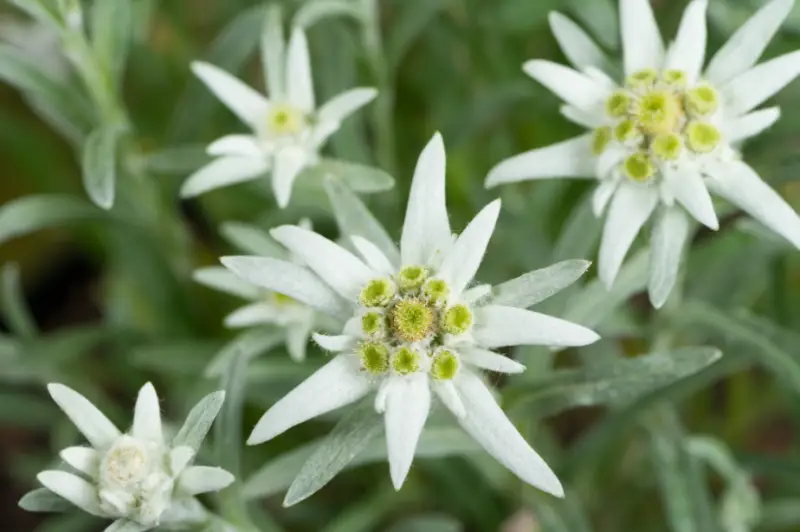The Edelweiss flower (Leontopodium alpinum) is a legendary symbol of alpine beauty and resilience, recognized for its woolly, lance-shaped leaves and white, star-shaped blossoms. Famous for growing in the harsh climates of the European Alps, its popularity rose with the song “Edelweiss” in The Sound of Music. Surprisingly, the Edelweiss flower has origins in the Himalayas and Siberia and can thrive in various alpine environments. This plant’s ability to survive in cold, windy, and rocky terrains makes it a wonderful addition to rock gardens and container setups.
Below is the complete guide on how to successfully grow and care for Edelweiss flowers, ensuring their long-term health and vitality in your garden.
Understanding Edelweiss: Key Plant Details

- Common Name: Edelweiss
- Botanical Name: Leontopodium alpinum
- Family: Asteraceae
- Type: Perennial
- Mature Size: 6-12 inches tall, 8 inches wide
- Sunlight: Full sun to partial shade
- Soil: Well-drained, slightly rocky
- Soil pH: Neutral
- Bloom Period: Spring and summer
- Flower Color: White
- Hardiness Zones: 4-7 (USDA)
- Native Regions: Asia
Planting Edelweiss in Your Garden
For best results, plant Edelweiss in early spring when the ground starts to thaw. Planting early allows the flower an entire growing season to establish its roots before winter sets in. Place the plant in a spot with full sunlight or partial shade for optimal growth.
Choosing the Right Soil
Edelweiss thrives in well-drained, rocky soil that mimics the plant’s native habitat. Ideal pH levels range from 6.5 to 7.5, making slightly acidic to neutral soil the best choice. Consider blending compost, sand, grit, and peat moss to ensure good drainage, which is vital to prevent root rot.
Lighting Needs
This alpine beauty prefers full sun but will tolerate light shade. Planting Edelweiss near taller plants can provide a natural canopy, protecting it from intense sunlight during peak hours while maintaining sufficient exposure.
Essential Care Tips for Healthy Edelweiss Flowers
Edelweiss is a hardy plant requiring only basic maintenance once it’s well-established. Below are core care guidelines for nurturing strong and vibrant Edelweiss plants:
Watering Schedule
Edelweiss is naturally adapted to low-water conditions and should be watered sparingly after its first year. During the initial growing period, water it whenever the soil feels dry. Once established, the plant prefers under-watering over overwatering to prevent fungal diseases.
Temperature and Humidity Preferences
Edelweiss is well-suited to cool climates and can withstand high winds and cold temperatures. Its woolly leaves offer natural protection against the elements, making it ideal for USDA hardiness zones 4 to 7. It is not suited for hot or humid regions, as excessive heat may stunt growth and prevent blooming.
Fertilizer Needs
These plants prefer nutrient-poor soil and generally do not require fertilization. Over-fertilizing can reduce their natural hardiness and prevent flowers from blooming. For best results, avoid adding extra nutrients and instead focus on well-draining soil.
Pruning Edelweiss Flowers for Optimal Growth
Edelweiss does not require extensive pruning. After the flowering period, remove spent flowers if you don’t want the plant to self-seed. Otherwise, let the flowers drop seeds naturally to encourage future growth and blooms in the garden.
Propagating Edelweiss for More Blooms
Edelweiss can be propagated through division every few years. Here’s how:
- In early spring, dig around the plant carefully to loosen the roots.
- Lift the plant from the ground and divide the root structure with garden snips, ensuring each section has healthy roots.
- Plant each division in a sunny area with well-draining soil to encourage fresh growth.
Starting Edelweiss from Seed: Growing Edelweiss from seed is relatively simple. Sow seeds outdoors just before the last frost to allow for natural cold stratification. Alternatively, place seeds in the refrigerator for three weeks if starting indoors. Once chilled, surface-sow seeds in well-draining soil, mist lightly, and keep them in a cool environment. Germination typically occurs in two to six weeks.
Potting Edelweiss in Containers
Edelweiss can be a wonderful addition to containers if provided with plenty of light and proper drainage. Use a pot with drainage holes and fill it with sandy or rocky soil for best results. Edelweiss is slow-growing, so repotting is generally not necessary unless the plant outgrows its container. When repotting, gently slide the plant from its container and place it in a slightly larger pot with fresh soil.
Winterizing Edelweiss for Seasonal Protection
In snowy climates, Edelweiss can withstand harsh winter conditions under a blanket of snow, which offers natural insulation. In areas with minimal snowfall, add a layer of mulch around the plant in late fall to mimic this effect. Reduce watering during winter to allow the plant to rest until spring.
Common Issues: Pests and Diseases
Edelweiss is relatively pest-free, making it an ideal choice for low-maintenance gardens. However, crown rot can occur if the plant is left in waterlogged soil. To prevent crown rot, always plant Edelweiss in well-drained soil and avoid excessive watering. Remove any fallen foliage around the plant to minimize the risk of soil-borne diseases.
Encouraging Edelweiss Blooms
Edelweiss blooms between late spring and early summer, usually reaching peak bloom in June and July. The flowers are short-lived, but with the right care, Edelweiss can produce blooms from spring through late summer. Key factors for more frequent blooming include:
- Sufficient sunlight exposure
- Well-drained, nutrient-poor soil
- Avoiding fertilization to prevent foliage growth over blooms
The delicate, woolly white petals surrounding pale yellow centers give Edelweiss its distinctive, star-shaped appearance. Though their fragrance is faint, they emit a subtle, sweet scent, reminiscent of hyacinth.
Companion Planting with Edelweiss
For a stunning alpine garden, pair Edelweiss with these complementary plants:
- Gentiana acaulis (Trumpet Gentian): A deep blue flower that contrasts beautifully with Edelweiss’s white blooms.
- Thymus serpyllum (Creeping Thyme): Its low-growing habit highlights Edelweiss’s unique form.
- Juniperus squamata ‘Blue Star’: Offers blue-green foliage that stands out against Edelweiss.
- Calluna vulgaris (Common Heather): Adds texture and color contrast, blending well in rock gardens.
- Campanula poscharskyana (Serbian Bellflower): Bright blue flowers provide a bold backdrop for Edelweiss.
- Myosotis sylvatica (Forget-me-nots): A classic spring bloom companion for Edelweiss.
Conclusion
Edelweiss flowers are a magnificent addition to rock gardens, containers, and alpine-inspired landscapes. By following these care tips—providing full sunlight, well-draining soil, and minimal watering—you can cultivate this iconic plant successfully. Although Edelweiss thrives in challenging environments, it’s surprisingly easy to maintain with the right conditions. Enjoy the unique beauty and elegance that Edelweiss brings to your garden for years to come.






